SKODA FABIA 2016 3.G / NJ Owner's Manual
Manufacturer: SKODA, Model Year: 2016, Model line: FABIA, Model: SKODA FABIA 2016 3.G / NJPages: 196, PDF Size: 31.86 MB
Page 171 of 196
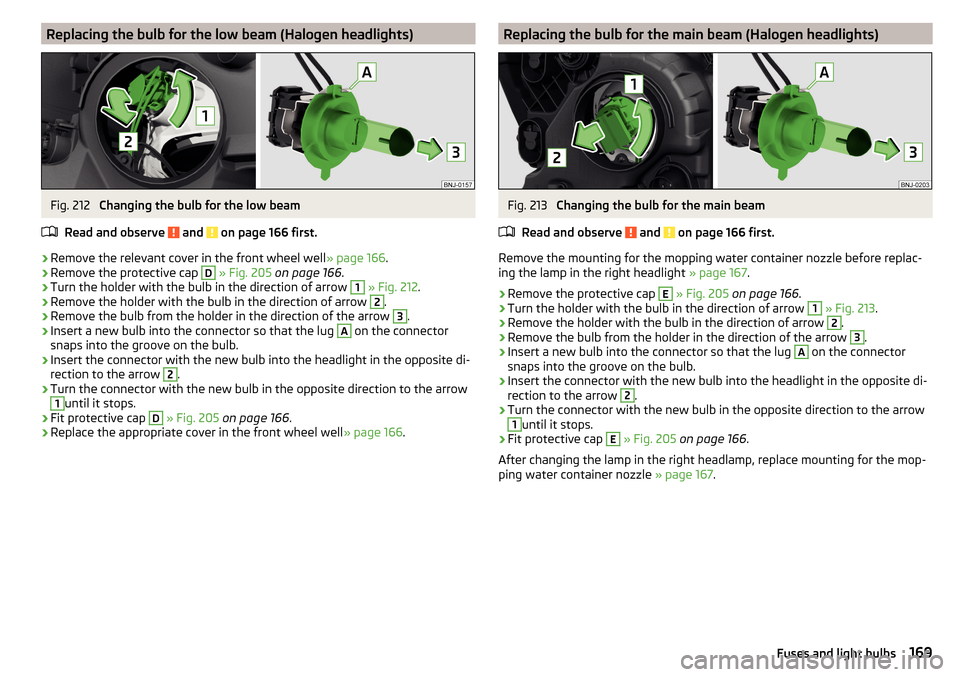
Replacing the bulb for the low beam (Halogen headlights)Fig. 212
Changing the bulb for the low beam
Read and observe
and on page 166 first.
›
Remove the relevant cover in the front wheel well » page 166.
›
Remove the protective cap
D
» Fig. 205 on page 166 .
›
Turn the holder with the bulb in the direction of arrow
1
» Fig. 212 .
›
Remove the holder with the bulb in the direction of arrow
2
.
›
Remove the bulb from the holder in the direction of the arrow
3
.
›
Insert a new bulb into the connector so that the lug
A
on the connector
snaps into the groove on the bulb.
›
Insert the connector with the new bulb into the headlight in the opposite di-
rection to the arrow
2
.
›
Turn the connector with the new bulb in the opposite direction to the arrow
1
until it stops.
›
Fit protective cap
D
» Fig. 205 on page 166 .
›
Replace the appropriate cover in the front wheel well » page 166.
Replacing the bulb for the main beam (Halogen headlights)Fig. 213
Changing the bulb for the main beam
Read and observe
and on page 166 first.
Remove the mounting for the mopping water container nozzle before replac-
ing the lamp in the right headlight » page 167.
›
Remove the protective cap
E
» Fig. 205 on page 166 .
›
Turn the holder with the bulb in the direction of arrow
1
» Fig. 213 .
›
Remove the holder with the bulb in the direction of arrow
2
.
›
Remove the bulb from the holder in the direction of the arrow
3
.
›
Insert a new bulb into the connector so that the lug
A
on the connector
snaps into the groove on the bulb.
›
Insert the connector with the new bulb into the headlight in the opposite di-
rection to the arrow
2
.
›
Turn the connector with the new bulb in the opposite direction to the arrow
1
until it stops.
›
Fit protective cap
E
» Fig. 205 on page 166 .
After changing the lamp in the right headlamp, replace mounting for the mop-
ping water container nozzle » page 167.
169Fuses and light bulbs
Page 172 of 196
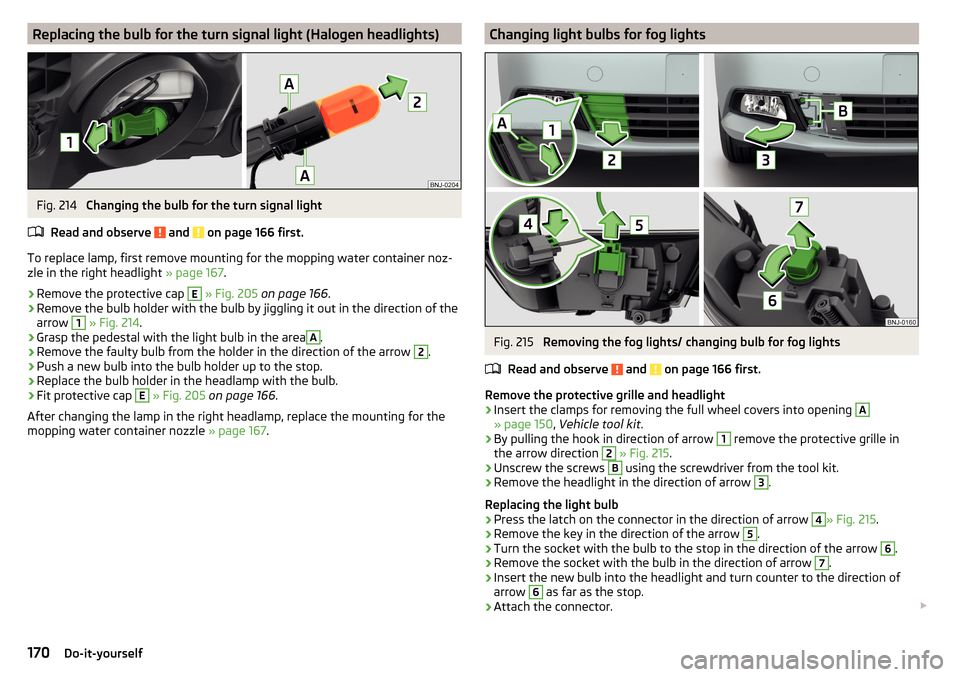
Replacing the bulb for the turn signal light (Halogen headlights)Fig. 214
Changing the bulb for the turn signal light
Read and observe
and on page 166 first.
To replace lamp, first remove mounting for the mopping water container noz-
zle in the right headlight » page 167.
›
Remove the protective cap
E
» Fig. 205 on page 166 .
›
Remove the bulb holder with the bulb by jiggling it out in the direction of the
arrow
1
» Fig. 214 .
›
Grasp the pedestal with the light bulb in the area
A
.
›
Remove the faulty bulb from the holder in the direction of the arrow
2
.
›
Push a new bulb into the bulb holder up to the stop.
›
Replace the bulb holder in the headlamp with the bulb.
›
Fit protective cap
E
» Fig. 205 on page 166 .
After changing the lamp in the right headlamp, replace the mounting for the
mopping water container nozzle » page 167.
Changing light bulbs for fog lightsFig. 215
Removing the fog lights/ changing bulb for fog lights
Read and observe
and on page 166 first.
Remove the protective grille and headlight
›
Insert the clamps for removing the full wheel covers into opening
A
» page 150 , Vehicle tool kit .
›
By pulling the hook in direction of arrow
1
remove the protective grille in
the arrow direction
2
» Fig. 215 .
›
Unscrew the screws
B
using the screwdriver from the tool kit.
›
Remove the headlight in the direction of arrow
3
.
Replacing the light bulb
›
Press the latch on the connector in the direction of arrow
4
» Fig. 215 .
›
Remove the key in the direction of the arrow
5
.
›
Turn the socket with the bulb to the stop in the direction of the arrow
6
.
›
Remove the socket with the bulb in the direction of arrow
7
.
›
Insert the new bulb into the headlight and turn counter to the direction of
arrow
6
as far as the stop.
›
Attach the connector.
170Do-it-yourself
Page 173 of 196
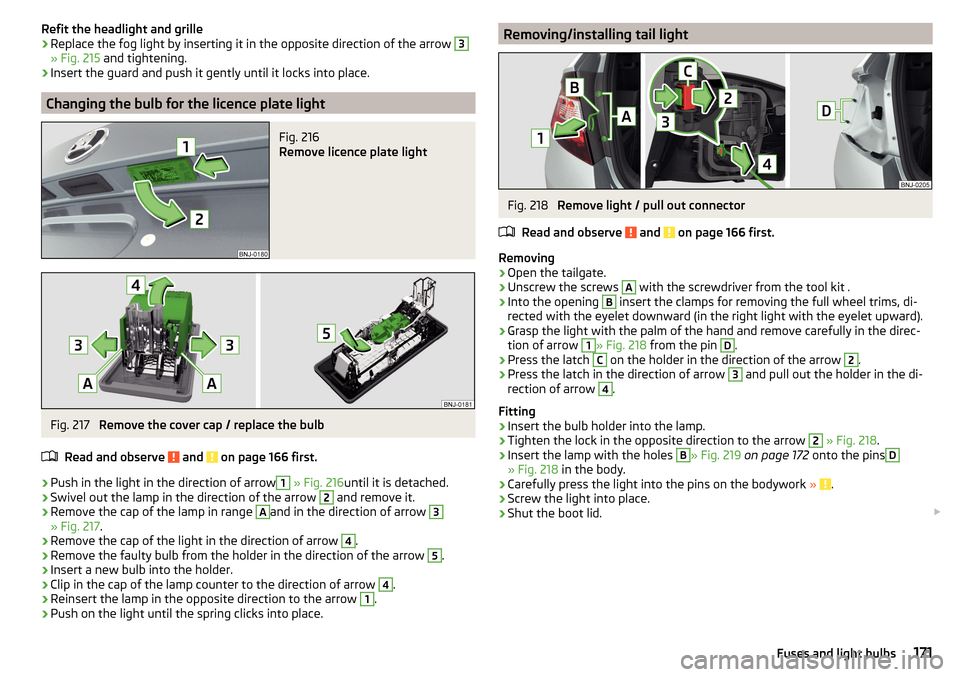
Refit the headlight and grille›Replace the fog light by inserting it in the opposite direction of the arrow 3
» Fig. 215 and tightening.
›
Insert the guard and push it gently until it locks into place.
Changing the bulb for the licence plate light
Fig. 216
Remove licence plate light
Fig. 217
Remove the cover cap / replace the bulb
Read and observe
and on page 166 first.
›
Push in the light in the direction of arrow
1
» Fig. 216 until it is detached.
›
Swivel out the lamp in the direction of the arrow
2
and remove it.
›
Remove the cap of the lamp in range
A
and in the direction of arrow
3
» Fig. 217.
›
Remove the cap of the light in the direction of arrow
4
.
›
Remove the faulty bulb from the holder in the direction of the arrow
5
.
›
Insert a new bulb into the holder.
›
Clip in the cap of the lamp counter to the direction of arrow
4
.
›
Reinsert the lamp in the opposite direction to the arrow
1
.
›
Push on the light until the spring clicks into place.
Removing/installing tail lightFig. 218
Remove light / pull out connector
Read and observe
and on page 166 first.
Removing
›
Open the tailgate.
›
Unscrew the screws
A
with the screwdriver from the tool kit .
›
Into the opening
B
insert the clamps for removing the full wheel trims, di-
rected with the eyelet downward (in the right light with the eyelet upward).
›
Grasp the light with the palm of the hand and remove carefully in the direc-
tion of arrow
1
» Fig. 218 from the pin
D
.
›
Press the latch
C
on the holder in the direction of the arrow
2
.
›
Press the latch in the direction of arrow
3
and pull out the holder in the di-
rection of arrow
4
.
Fitting
›
Insert the bulb holder into the lamp.
›
Tighten the lock in the opposite direction to the arrow
2
» Fig. 218 .
›
Insert the lamp with the holes
B
» Fig. 219 on page 172 onto the pins
D
» Fig. 218 in the body.
›
Carefully press the light into the pins on the bodywork » .
›
Screw the light into place.
›
Shut the boot lid.
171Fuses and light bulbs
Page 174 of 196
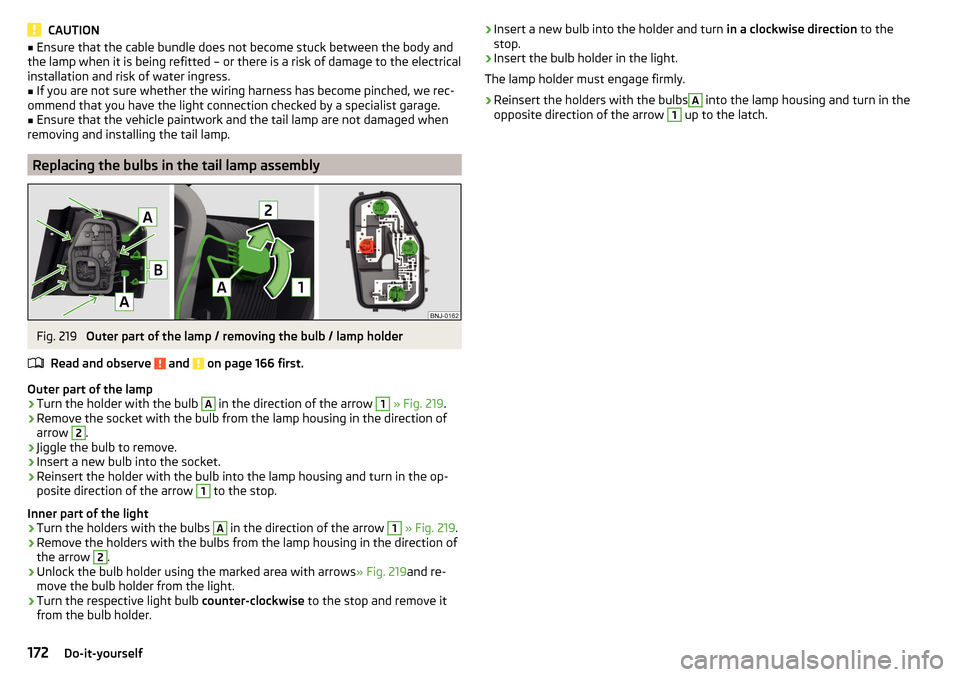
CAUTION■Ensure that the cable bundle does not become stuck between the body and
the lamp when it is being refitted – or there is a risk of damage to the electrical
installation and risk of water ingress.■
If you are not sure whether the wiring harness has become pinched, we rec-
ommend that you have the light connection checked by a specialist garage.
■
Ensure that the vehicle paintwork and the tail lamp are not damaged when
removing and installing the tail lamp.
Replacing the bulbs in the tail lamp assembly
Fig. 219
Outer part of the lamp / removing the bulb / lamp holder
Read and observe
and on page 166 first.
Outer part of the lamp
›
Turn the holder with the bulb
A
in the direction of the arrow
1
» Fig. 219 .
›
Remove the socket with the bulb from the lamp housing in the direction of
arrow
2
.
›
Jiggle the bulb to remove.
›
Insert a new bulb into the socket.
›
Reinsert the holder with the bulb into the lamp housing and turn in the op-
posite direction of the arrow
1
to the stop.
Inner part of the light
›
Turn the holders with the bulbs
A
in the direction of the arrow
1
» Fig. 219 .
›
Remove the holders with the bulbs from the lamp housing in the direction of
the arrow
2
.
›
Unlock the bulb holder using the marked area with arrows » Fig. 219and re-
move the bulb holder from the light.
›
Turn the respective light bulb counter-clockwise to the stop and remove it
from the bulb holder.
› Insert a new bulb into the holder and turn
in a clockwise direction to the
stop.›
Insert the bulb holder in the light.
The lamp holder must engage firmly.
›
Reinsert the holders with the bulbs
A
into the lamp housing and turn in the
opposite direction of the arrow
1
up to the latch.
172Do-it-yourself
Page 175 of 196

Technical data
Technical data
Basic vehicle data
Introduction
This chapter contains information on the following subjects:
Vehicle data
173
Operating weight
174
Payload
175
measurement of fuel consumption and CO 2 emissions according to ECE
Regulations and EU Directives
175
Dimensions
176
Departure angle
177
The details given in the vehicle's technical documentation always take prece-
dence over the details in the Owner's Manual.
The performance values listed were determined without performance-reduc- ing equipment, e.g. air conditioning system.
The specified values have been determined in accordance with rules and under
conditions set out by legal or technical requirements for determining opera-
tional and technical data for motor vehicles.
The listed values are for the basic model without optional equipment.
Vehicle dataFig. 220
Vehicle data sticker/type plate
Vehicle data sticker
The vehicle data sticker » Fig. 220 -
is located on the base of the luggage
compartment and is also stuck into the Owner's Manual.
The vehicle data sticker contains the following data. Vehicle identification number (VIN)
Vehicle type
Gearbox code / paint number / interior equipment / engine output / engine code
Partial vehicle description
Approved tyre diameter in inches 1)
The approved tyres and rim sizes for your vehicle are listed in the vehicle's
technical documentation (the so called COC document) and this also states the
declaration of conformity.
Type plate
The type plate » Fig. 220 -
is located at the bottom of the B-pillar on the
right-hand driver's side.
The type plate contains the following data. Vehicle manufacturers
Vehicle identification number (VIN)
Maximum permissible gross weight
Maximum permissible towed weight (towing vehicle and trailer)
1234567891)
Only valid for some countries.
173Technical data
Page 176 of 196

Maximum permissible front axle load
Maximum permissible rear axle load
Vehicle identification number (VIN)
The vehicle identification number - VIN (vehicle body number) is stamped on
the right hand suspension strut dome in the engine compartment. This num-
ber is also located on a sign on the lower left hand edge below the windscreen
(together with a VIN bar code), together with a nameplate.
The VIN number can also be displayed in Infotainment » Owner´s Manual Info-
tainment .
Engine number
The engine number (three-digit code letter and serial number) is stamped onto
the engine block.
Supplementary Information (applies to Russia)
The full type approval number of the means of transport is indicated in the
registration documents, field 17.
Maximum permissible trailer weight
The listed maximum permissible trailer weight is only valid for altitudes up to
1000 m above sea level.
The engine output falls as altitude increases, as does the ability to climb.
Therefore, for every additional 1,000 m in height (or part), the maximum per-
missible towed weight must be reduced by 10 %.
The towed weight comprises the actual weights of the (loaded) towing vehicle and the (loaded) trailer.WARNINGDo not exceed the specified maximum permissible weights – risk of an acci-
dent and damage.
Operating weight
This value is only a guide value and corresponds to the lowest possible operat-
ing weight without any equipment added that would also increase the weight
(e.g. air conditioning, emergency or spare wheel etc.). It also includes a weight
allowance for the driver (75 kg), the weight of the operating fluids, the tool kit
and a fuel tank filled to 90 % capacity.
1011Operating weight - FabiaEngineGearboxOperating weight (kg)1.0 l/44 kW MPIMG10551.0 l/55 kW MPIMG (EU6)1055MG (EU4)10501.2 l./66 kW TSIMG11091.2 ltr./81 kW TSIMG1129DSG11541.6 l./66 kW MPIMG10861.6 l./81 kW MPIAG11261.4 l/55 kW TDI CRMG11561.4 l/66 kW TDI CRMG1156DSG11861.4 l/77 kW TDI CRMG1165
Operating weight - Fabia Combi
EngineGearboxOperating weight (kg)1.0 l/55 kW MPIMG (EU6)1079MG (EU4)10741.2 ltr./66 kW TSIMG11331.2 ltr./81 kW TSIMG1153DSG11781.6 l./66 kW MPIMG11101.6 l./81 kW MPIAG11501.4 l/55 kW TDI CRMG11801.4 l/66 kW TDI CRMG1180DSG12101.4 l/77 kW TDI CRMG1189
Note
If required, you can find out the precise weight of your vehicle by contacting a
specialist garage.174Technical data
Page 177 of 196

Payload
It is possible to calculate the approximate loading capacity from the difference
between the permissible total weight and the operating weight.
The payload consists of the following weights.
▶ The weight of the passengers.
▶ The weight of all items of luggage and other loads.
▶ The weight of the roof, including the roof rack system.
▶ The weight of the equipment that is excluded from the operating weight.
▶ Trailer drawbar load when towing a trailer (max. 50 kg).
measurement of fuel consumption and CO
2 emissions according to
ECE Regulations and EU Directives
The data on fuel consumption and CO 2 emissions were not available at the
time of going to press.
The data on fuel consumption and CO 2 emissions are given on the ŠKODA
websites or in the sales and technical vehicle documentation.
The measurement of the intra-urban cycle begins with a cold start of the en-
gine. Urban driving is then simulated.
In the extra-urban driving cycle, the vehicle is accelerated and decelerated in
all gears, corresponding to daily routine driving conditions. The driving speed
varies between 0 and 120 km/h.
The calculation of the combined fuel consumption considers a weighting of
about 37 % for the intra-urban cycle and 63 % for the extra-urban cycle.
Note
■ The emission and fuel consumption figures given on the ŠKODA websites or
in the commercial and technical vehicle documentation have been established
in accordance with rules and under conditions that are set out by statutory or
technical rules for the determination of operational and technical data of mo-
tor vehicles.■
Depending on the extent of the equipment, the driving style, traffic condi-
tions, weather influences and vehicle condition, consumption values can in
practice result in fuel economy figures in the use of the vehicle that differ from
the fuel consumption values listed on the ŠKODA websites or in the commer-
cial and technical vehicle documentation.
175Technical data
Page 178 of 196

DimensionsFig. 221
Vehicle dimensions
Vehicle dimensions by operating weight without driver (in mm)
» Fig. 221SpecificationFabiaFabia CombiAHeight14671467BFront trackBasic dimension14631463Vehicles with the 1.2 l/81 kW TSI and 1.4 l/77 kW TDI engine14571457CWidth17321732DRear trackBasic dimension14571457Vehicles with the 1.2 l/81 kW TSI and 1.4 l/77 kW TDI engine14511451EWidth including exterior mirrors19581958FClearance133135GWheelbase24702470HLength39924257176Technical data
Page 179 of 196
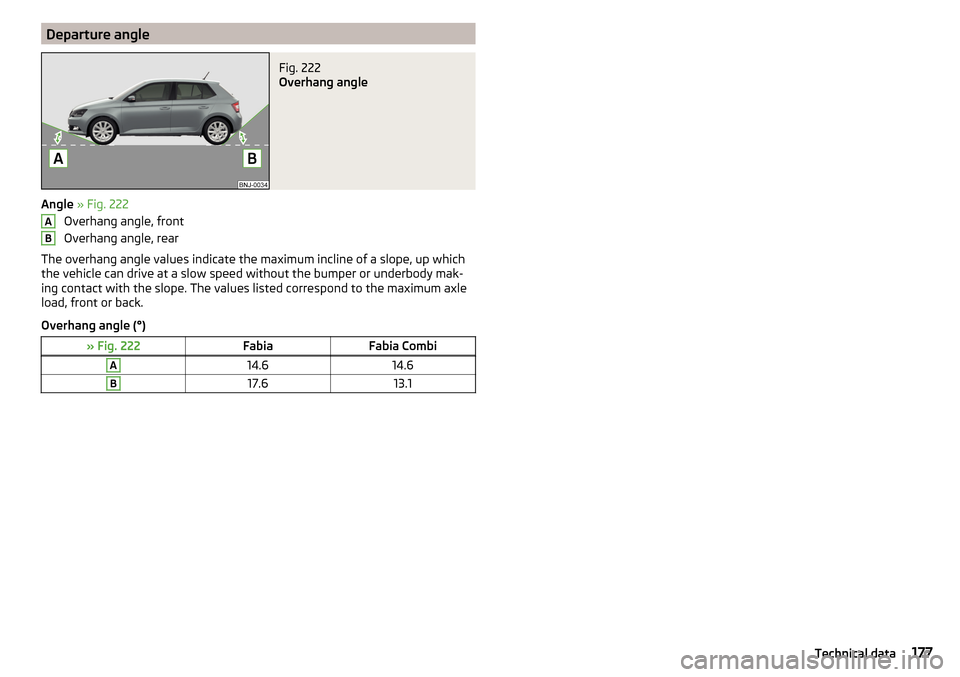
Departure angleFig. 222
Overhang angle
Angle » Fig. 222
Overhang angle, front
Overhang angle, rear
The overhang angle values indicate the maximum incline of a slope, up which the vehicle can drive at a slow speed without the bumper or underbody mak-
ing contact with the slope. The values listed correspond to the maximum axle
load, front or back.
Overhang angle (°)
» Fig. 222FabiaFabia CombiA14.614.6B17.613.1AB177Technical data
Page 180 of 196

Vehicle-specific details per engine type
Introduction
This chapter contains information on the following subjects:
1.0 l/44 kW MPI engine
178
1.0 l/55 kW MPI engine
178
1.2 ltr./66 kW TSI engine
179
1.2 ltr. / 81 kW TSI engine
179
1.6 l/66 kW MPI engine
179
1.6 l/81 kW MPI engine
1801.4 l/55 kW TDI CR engine1801.4 l/66 kW TDI CR engine180
1.4 l/77 kW TDI CR engine
181The specified values have been determined in accordance with rules and un-
der conditions set out by legal or technical requirements for determining op-
erational and technical data for motor vehicles.The emission standard is listed in the vehicle technical documentation and
the declaration of conformity (the COC document), which can be obtained
from a ŠKODA partner a)
.a)
Only valid for some countries and some models.
1.0 l/44 kW MPI engineOutput (kW at rpm)44 / 5000-6000Maximum torque (Nm at 1/min)95 / 3000-4300Number of cylinders/displacement (cm 3
)3/999BodyFabiaGearboxMGTop speed (km/h)160Acceleration 0-100 km/h (s)15.7
1.0 l/55 kW MPI engine
Output (kW at rpm)55/6200Maximum torque (Nm at 1/min)95 / 3000-4300Number of cylinders/displacement (cm 3
)3/999BodyFabiaFabia CombiTransmissionMGMGTop speed (km/h)172175Acceleration 0-100 km/h (s)14.714.9178Technical data